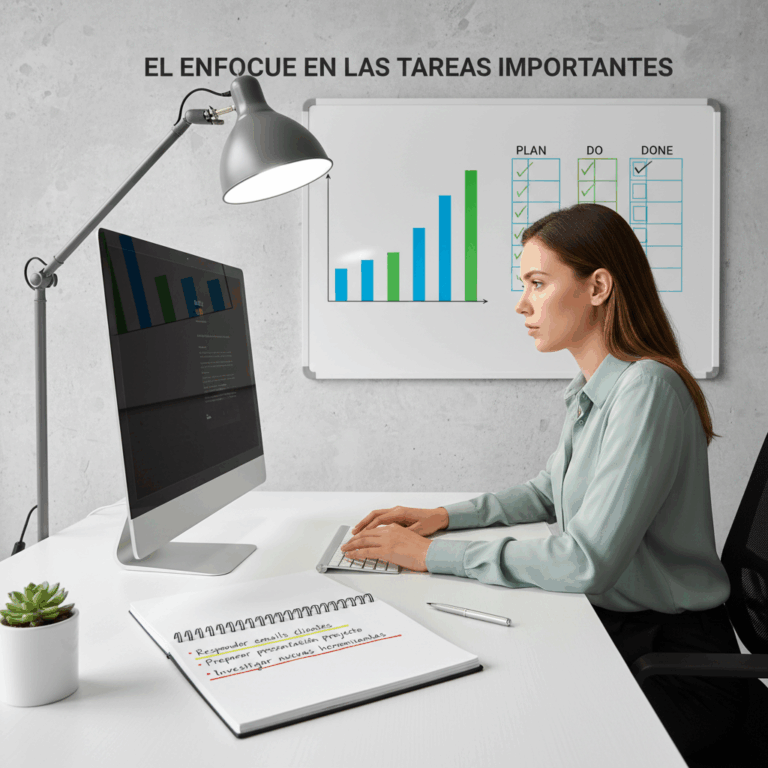Advertisements
Identifying important and urgent tasks
To improve productivity, it's essential to distinguish between **important** and **urgent** tasks. This distinction allows you to focus your time on activities that truly add value.
Correct identification helps avoid distractions and prioritize effectively, increasing the quality of work and reducing the stress associated with time management.
Using appropriate tools facilitates the classification of tasks according to their impact and urgency, improving organization and the achievement of objectives.
Eisenhower Matrix and its classification
The Eisenhower Matrix It divides tasks into four quadrants according to their urgency and importance, helping to prioritize clearly. This makes it easier to make decisions about what to do, delegate, or eliminate.
Advertisements
Urgent and important tasks must be addressed immediately, as they have a direct impact on critical goals. Conversely, important but not urgent tasks require planning to prevent them from escalating into crises.
Urgent but not important tasks are usually delegated or done quickly to free up time, while those that are neither urgent nor important should be discarded to avoid wasting resources.
Prioritizing tasks based on impact and urgency
Understanding the impact of each task is key to prioritizing. Not all urgent matters deserve immediate attention if they don't offer a substantial benefit.
Advertisements
Prioritizing according to urgency and impact allows you to focus energy on activities that drive results, minimizing effort on low-value tasks or distractions.
Planning and organizing activities based on this criterion helps maintain focus, improve efficiency, and ensure the achievement of short- and long-term goals.
Strategies to increase focus and productivity
To improve focus and productivity, it is essential to implement strategies that reduce distractions and optimize the use of time on important tasks.
These techniques allow you to maintain concentration, avoiding distractions and increasing efficiency when performing key activities to achieve goals.
Applying effective methods, such as time blocks and task grouping, facilitates in-depth work and significantly improves the results obtained.
Blocks of time for uninterrupted concentration
Allocating specific blocks of time to work on important tasks without interruptions improves focus and the quality of work performed.
During these periods, it is advisable to turn off notifications and create a distraction-free environment to maximize concentration.
This practice helps reduce stress and avoids fragmentation of time, allowing the mind to remain focused on priority activities.
Grouping similar tasks to improve concentration
Grouping similar tasks into specific blocks avoids constant context switching, which often leads to wasted time and mental dispersion.
For example, allocating a block for calls or for answering emails improves flow and speeds up execution, increasing productivity.
This strategy also facilitates entering a state of sustained concentration, optimizing performance on related tasks.
Pomodoro Technique for high concentration intervals
The Pomodoro Technique divides time into 25-minute intervals of intense concentration followed by short breaks, ideal for maintaining high attention.
This methodology helps to avoid mental fatigue and improves discipline, facilitating the management of complex tasks or those that require in-depth analysis.
In addition, the interspersed breaks allow you to recover energy and maintain a constant and sustainable work pace.
Effective planning and delegation
Planning tasks in advance on a calendar ensures that specific time slots are allocated for priority activities, making it easier to complete them.
This planning prevents procrastination and allows you to clearly visualize the time available for each task, improving daily organization.
Furthermore, delegating activities that do not require direct attention frees up resources and allows you to concentrate on tasks that truly provide strategic value.
Schedule tasks on a calendar to meet priorities
Assigning tasks to the calendar helps turn priorities into concrete commitments, reducing procrastination and improving time management.
Visualizing scheduled activities makes it easier to adjust priorities as needed, avoiding overload and ensuring that important things are not left out.
Scheduling also allows for balancing the workload and reserving time for breaks, maintaining high productivity throughout the day.
Delegate tasks that do not require direct attention
Delegating less critical tasks frees up time to focus on essential matters that require your expertise and direct decision-making.
Identifying which activities can be assigned to others optimizes team performance and prevents the manager from becoming overwhelmed with minor details.
Optimizing the focus on concrete results
To maximize productivity, it's crucial to shift the focus from performing many tasks to achieving concrete and meaningful results. This allows for the optimization of time and resources.
Focusing on quality over quantity helps to move towards clear objectives, avoiding dispersing efforts on activities that do not add real value to the project or company.
Adopting this mindset promotes strategic decision-making, facilitating the achievement of goals and improving personal and professional satisfaction.
Shift from quantity to quality in task management
Quality-oriented management prioritizes tasks that generate concrete and relevant results, rather than simply completing many activities without impact.
This change involves dedicating more time and attention to each important task, improving the effectiveness and value they bring to achieving objectives.
In addition, it helps reduce exhaustion and stress caused by the accumulation of tasks, promoting more mindful and focused work.
By focusing on quality, results are obtained that drive real progress, promoting sustainable development that is consistent with priorities.
Elimination of tasks that do not add value
Eliminating tasks that do not contribute to achieving goals frees up time and energy to focus on truly important and productive activities.
This practice requires constantly evaluating each activity, identifying those that are dispensable or that can be effectively delegated.
Getting rid of unnecessary tasks reduces distractions and improves focus, facilitating a clearer workflow that is aligned with goals.







